Over the last several years, Isle of Wight County and the town of Smithfield have quietly emerged as two of the most active residential growth zones in the Hampton Roads region. While the area has long been known for its farmland, waterfront views, and small-town character, a noticeable shift is underway. New housing developments are rising, populations are climbing, and the real estate landscape is changing.
So, what’s behind the momentum—and what does it signal about the future of this part of coastal Virginia?
A Growing Preference for Space, Access, and Simplicity
The appeal of Isle of Wight and Smithfield isn’t tied to any one factor—it’s the result of several overlapping trends.
First, there’s the regional affordability gap. As prices in core Hampton Roads cities like Norfolk, Chesapeake, and Virginia Beach continue to rise, buyers are looking further out. Isle of Wight offers newer homes, more land, and competitive pricing—without pushing buyers into truly rural territory.
Second, connectivity remains strong. With U.S. Route 17 and Route 10 running through the region, commutes to larger employment centers remain feasible. For many residents, the area represents a balance: far enough from congestion, but still connected to jobs, schools, and services.
Finally, post-pandemic lifestyle shifts—including remote work and greater value placed on space and community—have led many buyers to reassess what they want in a place to live. Areas like Smithfield and Carrollton (just east of Isle of Wight) have benefitted from that shift.
Notable Developments Reflecting the Growth
The rise in population and housing demand can be seen clearly in the number and scale of new residential developments underway. Each one reflects different aspects of the area’s appeal:
- Benn’s Grant: A large, master-planned community offering single-family homes, townhomes, trails, and amenities. Its location near Carrollton makes it a draw for families commuting east.
- Bartlett Station: A newer development emphasizing walkability and proximity to downtown Smithfield, catering to buyers looking for a balance of tradition and access.
- Nest on 17: Built along Route 17, this modern, eco-conscious community reflects growing demand for energy-efficient homes and a simplified living experience.
- Brewer’s Station: Positioned as a more affordable option, this development opens the door for younger buyers and first-time homeowners.
- South Harbor: With river views and larger lots, South Harbor appeals to buyers interested in waterfront living without moving deep into rural territory.
Each development represents a slightly different segment of the market—from growing families to downsizers to hybrid and remote workers. Together, they illustrate the area’s broader transformation.
What’s Driving Developers to the Area?
From a developer’s perspective, Isle of Wight and Smithfield offer several advantages:
- Available land compared to denser neighboring localities
- Zoning and permitting flexibility in some submarkets
- Rising demand across multiple price points
- Strong public schools and community infrastructure already in place
In short, it’s a buildable, bankable part of the region with buyer interest to match. While growth is being monitored closely by county and town officials, the tone has been generally proactive—encouraging responsible development without losing sight of the area’s rural and historical identity.
The Takeaway: A Region in Transition
While Isle of Wight and Smithfield aren’t the only areas seeing residential growth in coastal Virginia, they are among the most illustrative. They represent a clear shift in how and where people want to live—driven by lifestyle preferences, economic realities, and long-term planning.
Whether that momentum continues at the same pace remains to be seen. But for now, the story is simple: more people are moving west of the core cities—not for novelty, but for something familiar, flexible, and just a little quieter.
By: Evan Pugh & Thomas McCoy, MAI




